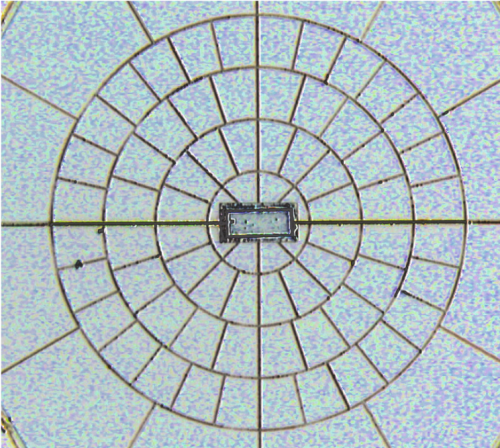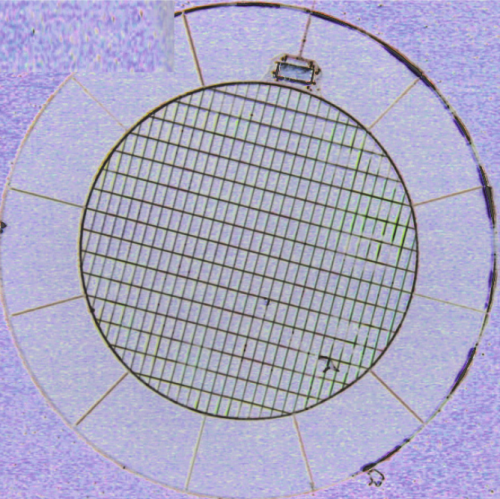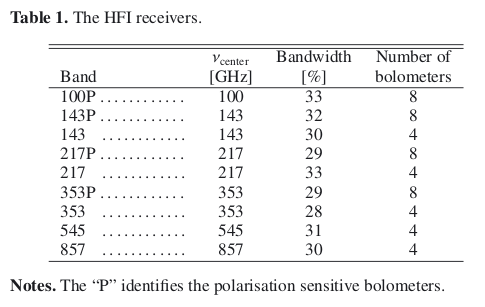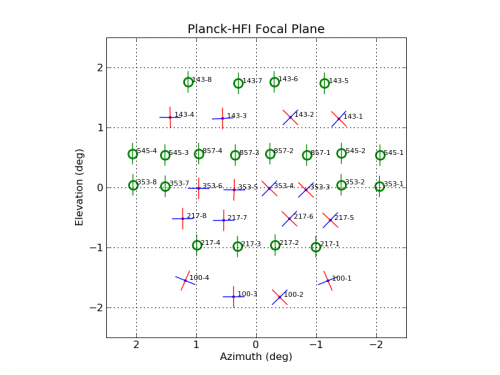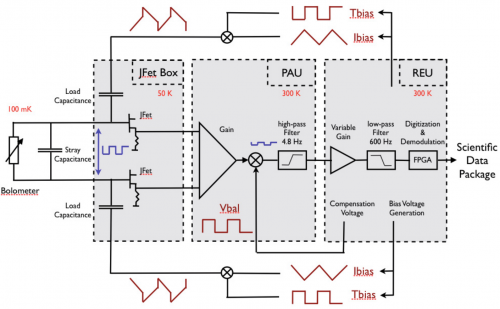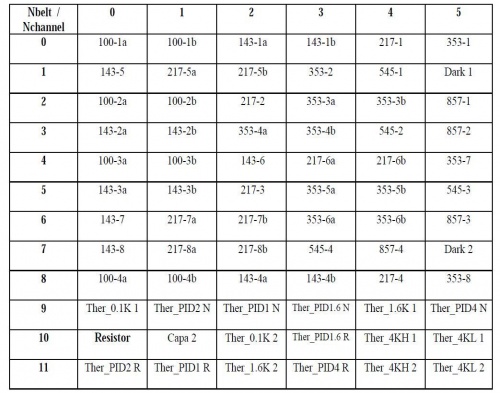HFI detection chain
Contents
Bolometers[edit]
The heart of the HFI - the detectors - are bolometers, solid-state devices in which the incoming radiation dissipates its energy as heat that increases the temperature of a thermometer. The instrument Flight Model total number of bolometers is 52, split into 6 channels at central frequencies of 100, 143, 217, 353, 545, and 857 GHz. Two extra bolometers not optically coupled to the telescope are added to the focal plane to monitor thermal noise (Dark Bolometers).
Thirty two of these bolometers are polarization sensitive allowing a map of the CMB polarisation to be built.
Bolometers consist of (i) an absorber that transforms the in-coming radiation into heat; (ii) a thermometer that is thermally linked to the absorber and measures the temperature changes; and (iii) a weak thermal link to a thermal sink, to which the bolometer is attached.
The thermometers are semi-conducting NTD thermistor bolometers. There are two kinds of detector modules:
- Spider web bolometers or SWBs (Bock et al. 1995; Mauskopf et al. 1997).
#Bock1995 Planck early paper IV #Mauskopf1997 Planck early paper IV
In these bomometers, the absorber consists of a metallic grid deposited on a Si3 N4 substrate in the shape of a spider web.
The mesh design and the impedance of the metallic layer are
adjusted to match vacuum impedance and maximize the absorption of millimeter waves, while minimizing the cross section to
particles. The absorber is designed to offer equal impedance to
any linearly polarised radiation. Nevertheless, the thermometer
and its electrical leads define a privileged orientation that
makes the SWBs slightly sensitive to polarisation, as detailed in
(Rosset et al. 2010 #Rosset2010 Planck early paper IV ). The thermometers are
made of neutron transmuted doped (NTD) germanium (Haller #Haller1996 Planck early paper IV
et al. 1996), chosen to have an impedance of about 10 MΩ at
their operating temperature.
- Polarization sensitive bolometers or PSBs.
The absorber of PSBs is a rectangular grid with metallization in one direction (Jones et al. 2003). Electrical fields parallel to this direction develop currents and then deposit some energy in the grid, while perpendicular electrical fields propagate through the grid without significant interaction. A second PSB perpendicular to the first one absorbs the other polarisation. Such a PSB pair measures two polarisations of radiation collected by the same horns and filtered by the same devices, which minimises the systematic effects: differences between polarised beams collected by a given horn are typically less than −30 dB of the peak. The differences in the spectral responses of a PSB pair also proved to be a few percent in the worst case. Each pair of PSBs sharing the same horn is able to measure the intensity Stokes parameter and the Q parameter associated with its local frame. An associated pair of PSBs rotated by 45◦ scans exactly the same line (if the geometrical alignment is perfect), providing the U Stokes parameter.
The detectors operate at a temperature close to 100 mK, while the filters are distributed on the 100 mK, 1.6 K, and 4 K stages in such a way that the heat load on the coldest stages is minimized to limit the heat load on the detectors and to decrease the heat lift requirement and thus enhance the mission lifetime. The self-emission of the 4K stage is minimised to limit the photon noise contribution on the detectors from the instrument. The HFI Focal Plane Unit accommodates sub-millimiter absorbing material in order to decrease the scattering inside it.
Focal plane layout[edit]
The layout of the detectors in the focal plane is defined in relation to the scanning strategy. The HFI horns are positioned at the centre of the focal plane, where the optical quality is good enough for the high frequencies. The curvature of rows compensates for the distortion of images by the telescope. A pair of identical SWB will scan the same circle on the sky to provide redundancy. Similar horns feeding PSBs are also aligned so that two PSBs rotated by 45◦ with respect to each other scan the same line. This will provide the Q and U Stokes parameters with minimal correction for the pointing (Rosset et al. 2010). Residual systematics will come from the differences between the beam shapes of the two horns. In all cases except for the 100 GHz horns, a measurement is also done by a pair of similar channels shifted by 1.25 arcminutes in the cross-scan direction, to ensure adequate sampling. In the figures focal plane layout is reported.
Readout[edit]
The AC bias readout electronics of the HFI instrument (Gaertner et al. 1997) includes the following features
- the cold load resistors were replaced by capacitors because they have no Johnson noise;
- the detectors are biased by applying a triangular voltage to the load capacitors which produces a square current (Ibias) in the capacitors, and a square voltage (T bias) that compensates for the stray capacitance of the wiring (producing a nearly square bias current into the bolometer;
- a square offset com-pensation signal is subtracted to the bolometric signal to minimise the amplitude of the signal that has to be amplified and digitized;
- the electronic scheme is symmetrical and uses a differential amplification scheme to optimize the immunity to electromagnetic interferences;
- and finally every parameter of the REU can be set by commands, which is made possible by using digital-to-analog and analog-to-digital converters extensively.
The readout electronics consists of 72 channels designed to perform low noise measurements of the impedance of 52 bolometers, two blind bolometers, 16 accurate low-temperature thermometers, all in the 10 MΩ range, one resistor of 10 MΩ and one capacitor of 100 pF. The semiconductor bolometers and thermometers of Planck-HFI operate at cryogenic temperature around 100 mK on the focal plane, with impedance of about 10 MΩ when biased at the optimal current. The readout electronics on the contrary has to operate at “room” temperature (300 K). The distance between the two extremities of the readout chain is about 10 m and could bring about an extreme susceptibility to electromagnetic interference. The readout electronic chain was split into three boxes. These are the JFET box, located on the 50 K stage of the satellite at 2.2 m from the focal plane, the pre-amplifier unit (PAU), located 1.8 m further at 300 K, and the REU, located on the opposite side of the satellite, 5 m away. Each of the three boxes (JFET, PAU and REU) consists of 12 belts of six channels. The first nine belts are dedicated to the bolometers, and the three last ones to the accurate thermometers, the resistor and the capacitor.
Principles of the readout electronics[edit]
See figure [Principles of readout electronics]. The bolometer is biased by a square wave AC current obtained by the differentiation of a triangular voltage through a load capacitance, in a completely differential architecture. The presence of the stray capacitance due to losses of charge in the wiring requires a correction of the shape of the square bias current by a transient voltage. Thus the bias voltage generation is controlled by the two parameters I-bias and T-bias that express the amplitude of the triangular and transient voltage. The compensation voltage added to the bolometric signal to optimize the dynamic of the chain is controlled by the V-bal parameter.
Parameters of the Readout Unit can be set to optimize the detector performance.
fmod, the modulation frequency of the square bias current, was set to 90.18685, Nsample, which defines the number of samples per half period of modulated signal was set to 40.
Each channel has its own settings for the following parameters: I-bias, amplitude of the triangular bias voltage;
T-bias, amplitude of the transient bias voltage;
V-bal, amplitude of the square compensation voltage;
G-amp, value of the programmable gain of the REU [1/3, 1, 3, 7.6];
N-blank, number of blanked samples at the beginning of halfperiod not taken into account during integration of the signal;
S-phase, phase shift when computing the integrated signal.
All these parameters influence the effective response of the detection chains, and were optimized during the calibration campaigns and confirmed during the calibration and performance verification (CPV) phase following the launch of Planck. The scientific signal is provided by the integral of the signal on each half-period, between limits fixed by the S-phase and N-blank parameters.
The interaction of modulated readout electronics with semiconductor
bolometers is rather different from that of a classical
DC bias readout (Jones 1953). The differences were seen during
the calibration of the HFI, although the readout electronics
was designed to mimic the operation
of a DC biased bolometric system as far as possible. With the
AC readout the maximum of responsivity is lower and is obtained
for higher bias current in the bolometer with respect to the DC model.
This is caused by the stray capacitance in the
wiring which has negligible effects for a DC bias and a major
effect for an AC bias. In our case, a stray capacitance of 150 pF
induces increases of NEP ranging from 4% (857 GHz bolometers)
to 10% (100 GHz bolometers) and also affects the HFI time
response. Details of the effect of the HFI AC bias system into
the time response of the detectors are discussed in the
Time Response Section.
JFETs[edit]
Given the high impedance of the bolometers and the length of the connecting cables, it is essential that the impedance of the signal is lowered as close as possible to the detectors. In our system this is accomplished by means of JFET source followers, located in boxes connected to the 50 K stage. The JFET box has been designed, developed and tested in the Observational Cosmology group in the Physics Department of the University of Rome "La Sapienza" (Brienza D. et al 2006). There are two JFETs per channel, since the readout is fully differential, and they provide a current amplification of the signal while keeping the voltage amplification very close to unity.
Inside the box, the JFETs are mounted on a thermally insulated plate with an active temperature control to keep them at the optimal temperature of 110 K. With a dissipated power lower than 240 mW, mainly produced by the JFETs and the source resistors, we obtained a noise power spectral density of less than 3 nV Hz1/2 for the frequency range of interest. This increases the total noise of all bolometer channels by less than 5%.
Time response[edit]
The HFI bolometers and readout electronics have a finite response-time to changes of the incident optical power modeled as a Fourier domain transfer function (called the LFER4 model). LFER4 has two factors. The first one represents the bolometer thermal response, driven by its heat capacity, the thermal link to the bolometer plate at 100 mK, and by the thermo-electrical feed-back (ref. Catalano et al.) resulting from the heat deposited in the bolometer by the readout electronics. This factor is empirically obtained from the observation of sources. The second factor is simply the time response of the part of the readout electronics that amplifies and digitizes the signal. It is obtained by modelling the electronics with only very few free parameters.
The time response of the HFI bolometers and readout electronics is modeled as a Fourier domain transfer function (called the LFER4 model) consisting of the product of a bolometer thermal response and an electronics response .
Due to Planck's nearly constant scan rate, the time response is degenerate with the optical beam. However, because of the long time scale effects present in the time response, the time response is deconvolved from the data in the processing of the HFI data (see TOI processing). is tuned to optimize the "compactness" of the beams reconstructed with the deconvolved signal from planets.
Details about the time response model are to be found in this annex.
Data compression[edit]
The output of the readout electronics unit (REU) consists of one value for each of the 72 science channels (bolometers and thermometers) for each modulation half-period. This number, , is the sum of the 40 16-bit ADC signal values measured within the given half-period. The data processor unit (DPU) performs a lossy quantization of .
Details about the data compression scheme, performance of the data compression during the mission, setting the quantization step in flight, impact of the data compression on science are given in this annex.
(Planck) High Frequency Instrument
Cosmic Microwave background
Readout Electronic Unit
Junction Field Elect Transistor
Pre_Amplification Unit
Calibration and Performance Verification
Noise Equivalent Power
analog to digital converter
Data Processing Unit
